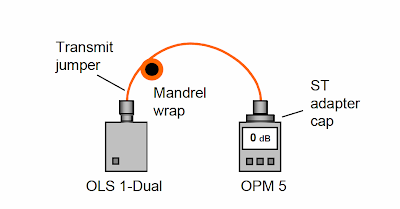Over the past 15 years we've sold all kinds of fiber products for all kinds of different projects but I think the most overlooked part about a fiber optic network installation might be the use of fiber optic mandrels for proper insertion loss testing.
Before we get into the mandrels themselves let's all get on the same page with "ZEROING" your fiber optic light source and power meter. Our good friend Professor Jim Powers with Optical Wavelength Laboratories gives us a great explanation on "ZEROING".
Thanks Professor Jim Powers, now let's get into the mandrel.
Your LED light source emits light over an area larger than the typical multimode fiber core causing the low and high order modes to get excited. The simplest way to calm your light source down is to tightly bend the launch cable from your light source tester around a mandrel.
A fiber optic mandrel is a very inexpensive tool to help improve your fiber optic testing as the tight bends around the mandrel calm the light source down. Mandrels allow the use of your overfilled LED light source to properly certify 50 and 62.5 fiber links for high bit rates such as Gigabit Ethernet and 10 Gigabit Etherent.
Here's a up close look from our YouTube channel
These mandrels are not a "want to" or "don't want to" tool to use during testing. This is not 'Nam, there are rules, and according to TIA/EIA-568-B it specifies that attenuation (insertion loss) measurements of multimode fiber links for all applications be made using an overfilled light source, such as an LED with a mandrel-wrap mode filter on the transmit jumper. This enables certification of multimode links for Gigabit and 10 Gigibit. Also allows for existing 850/1300 LED light sources to test 50 and 62.5 links.
Now let's use our fiber mandrel for "ZEROING"!
Wrap the "transmit jumper" five times around the mandrel and attach it to the output port of your LED source. Then attach the other end of the jumper to your power meter and set your wavelength.
Set your reference to display "0 dB" indicating that the power measured at output of the transmit jumper has been recorded as the reference level for your insertion loss measurements. You have now completed the "One Jumper Method".
Now disconnect your transmit jumper from your power source but NOT from your light source. Attach a "receive jumper" to to your power meter. Mate together the "transmit jumper" and "receive jumper" with a coupler. Make sure that the insertion loss is well under 0.75 dB and that is the maximum allowed by TIA.
Now your ready to test the fiber link. Connect your light source to one end and your power meter to the other. Store results, print and rock and roll!
So long story short, a fiber mandrel is for modifying the distribution of a propagating fiber optic signal. You can order your fiber optic mandrel from DLV.
Almost forgot to show the mandrel in action, here a How-To video on DB loss.
Questions? Comment below, thanks!
"By Mercy Salinas"
Before we get into the mandrels themselves let's all get on the same page with "ZEROING" your fiber optic light source and power meter. Our good friend Professor Jim Powers with Optical Wavelength Laboratories gives us a great explanation on "ZEROING".
Thanks Professor Jim Powers, now let's get into the mandrel.
Your LED light source emits light over an area larger than the typical multimode fiber core causing the low and high order modes to get excited. The simplest way to calm your light source down is to tightly bend the launch cable from your light source tester around a mandrel.
A fiber optic mandrel is a very inexpensive tool to help improve your fiber optic testing as the tight bends around the mandrel calm the light source down. Mandrels allow the use of your overfilled LED light source to properly certify 50 and 62.5 fiber links for high bit rates such as Gigabit Ethernet and 10 Gigabit Etherent.
Here's a up close look from our YouTube channel
These mandrels are not a "want to" or "don't want to" tool to use during testing. This is not 'Nam, there are rules, and according to TIA/EIA-568-B it specifies that attenuation (insertion loss) measurements of multimode fiber links for all applications be made using an overfilled light source, such as an LED with a mandrel-wrap mode filter on the transmit jumper. This enables certification of multimode links for Gigabit and 10 Gigibit. Also allows for existing 850/1300 LED light sources to test 50 and 62.5 links.
Now let's use our fiber mandrel for "ZEROING"!
Wrap the "transmit jumper" five times around the mandrel and attach it to the output port of your LED source. Then attach the other end of the jumper to your power meter and set your wavelength.
Set your reference to display "0 dB" indicating that the power measured at output of the transmit jumper has been recorded as the reference level for your insertion loss measurements. You have now completed the "One Jumper Method".
Now disconnect your transmit jumper from your power source but NOT from your light source. Attach a "receive jumper" to to your power meter. Mate together the "transmit jumper" and "receive jumper" with a coupler. Make sure that the insertion loss is well under 0.75 dB and that is the maximum allowed by TIA.
Now your ready to test the fiber link. Connect your light source to one end and your power meter to the other. Store results, print and rock and roll!
So long story short, a fiber mandrel is for modifying the distribution of a propagating fiber optic signal. You can order your fiber optic mandrel from DLV.
Almost forgot to show the mandrel in action, here a How-To video on DB loss.
Questions? Comment below, thanks!
"By Mercy Salinas"



No comments:
Post a Comment